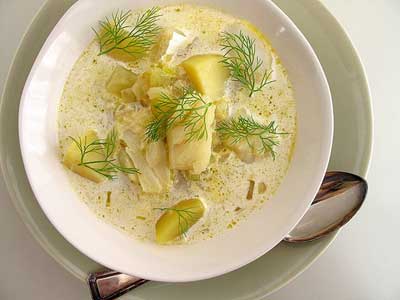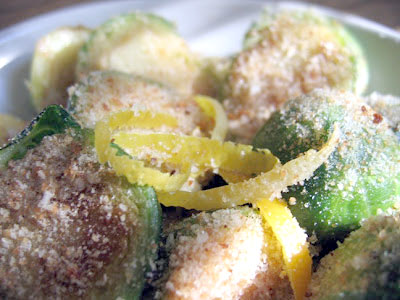 I can't think of anything more American than chowder. This seafood soup is synonymous with chilly days and large family gatherings. Even though we're almost into spring, the weather has continued to be cold and dreary here in the Northeast. I've been craving hot bowls of soothing soup. There are many different recipes for chowder, including the little-known Rhode Island-style made of clear broth. But the one I'm a fan of is creamy New England-style, which was probably the first recorded chowder recipe, dating back to the 18th century. It just so happens that I'm the outlier in a family of all Manhattan-style lovers. Still for me, the fish broth enriched with cream holds the most appeal. That richness is what makes this chowder so soul-satisfying.
I can't think of anything more American than chowder. This seafood soup is synonymous with chilly days and large family gatherings. Even though we're almost into spring, the weather has continued to be cold and dreary here in the Northeast. I've been craving hot bowls of soothing soup. There are many different recipes for chowder, including the little-known Rhode Island-style made of clear broth. But the one I'm a fan of is creamy New England-style, which was probably the first recorded chowder recipe, dating back to the 18th century. It just so happens that I'm the outlier in a family of all Manhattan-style lovers. Still for me, the fish broth enriched with cream holds the most appeal. That richness is what makes this chowder so soul-satisfying.
The recipe for chowder originally came from France ("chowder" comes from the word chaudière, meaning cauldron) and eventually made its way to England and over to the New World with the colonists. The recipe evolved according to the surroundings, availability of seafood, and the specific tastes of the region. Somewhere along the line certain recipes became more popular than others. Immigrants added their particular spin: the Portuguese added tomatoes to clear-broth chowder and invented what we know as Manhattan-style. That began the epic rivalry between New England- and Manhattan-style chowders, now typically made with clams. But the first chowders in America were made with fish.
Winter
Winter
How To Get Rid of a Rutabaga
 Me and my big ideas. Take rutabagas. I thought it would be just nifty to plant a row of these, late in the season, to use in our winter kitchen. (You can keep them right in the soil—how handy!) They’d be exclusively for us, not for the farm stand. Like the onions. Yes, but onions are a tad more versatile than rutabagas, you might point out. Duh.
Me and my big ideas. Take rutabagas. I thought it would be just nifty to plant a row of these, late in the season, to use in our winter kitchen. (You can keep them right in the soil—how handy!) They’d be exclusively for us, not for the farm stand. Like the onions. Yes, but onions are a tad more versatile than rutabagas, you might point out. Duh.
There are only so many rutabagas one can eat. It’s not even November and Roy is already looking a little rutabaga-weary. And this despite the fact that miraculously, Roy, who is not a huge veggie lover, is not turnip-averse. (Rutabagas are basically big, purple-skinned, yellow-fleshed turnips.)
I guess I got all rutabaga-smug because I figured I knew a bunch of tasty ways to cook them. This week, in fact, I slipped some into a potato gratin, and that was a definite hit. (Couldn’t have had anything to do with the cream and cheese.) And one of my favorite techniques—slowly caramelizing root vegetables in a crowded pan—works wonders on rutabagas, so I’ve been using this trick frequently. And Fall Veggie Minestrone is another great destination for rutabagas.
Brussels Sprouts on Botox

Not so at the cruciferous vegetables table. There lie the Brussels sprouts, kale, cabbages, broccoli, and cauliflower (of which only the funky Romanesco variety is getting any attention). These uncomely vegetables patiently wait for someone to come by and check them out. It is a long wait.
This past Sunday the Brussels sprouts were carelessly dumped in a lop-sided pile, causing stray runaway sprouts to keep rolling off the table's edge and onto the concrete. Inspired by Molly’s witty post at Orangette, I thought I would take on a challenge. A makeover for three undatable vegetables: Brussels sprouts, cauliflower, and broccoli. The make-up? Breadcrumbs.
Smokey Turnip and Parsnip Gratin
 Turnips and parsnips are not a taste I grew up with. It kind of surprises me as I was exposed to all kinds of different foods, heavy with Eastern European influence (not that the turnip or parsnip originated from that part of the world). However, root vegetables were a staple in my childhood household, but I don’t remember turnips and parsnips being part of the repertoire.
Turnips and parsnips are not a taste I grew up with. It kind of surprises me as I was exposed to all kinds of different foods, heavy with Eastern European influence (not that the turnip or parsnip originated from that part of the world). However, root vegetables were a staple in my childhood household, but I don’t remember turnips and parsnips being part of the repertoire.
Fast forward into adult life, my husband introduced me to what is now one of my favorite tastes, parsnips. Have you ever had parsnips mashed up like potatoes with butter and garlic? Or added them to soup? They are mild and sweet, and were used as a sweetener before the arrival in Europe of cane sugar. They mimic the taste of a roasted carrot, but with more complexity. I also add them to stews for a layer of unsuspected flavor.
For me, eating turnips was just a natural progression from parsnips. They are however very different in flavor from other root vegetables, more like a peppery radish with a bitter edge. Very distinct in taste but amazing when roasted, which brings on a milder flavor.
Enjoy Your Winter Salads Because Spring Salads May Be Late This Year
 I received some bad news at the supermarket the other day. After going to three stores searching for fresh fennel bulb and not finding a single one, I asked a produce manager if he had any. He told me that fennel was going to be sparse this season because of frosts in California that damaged many crops.
I received some bad news at the supermarket the other day. After going to three stores searching for fresh fennel bulb and not finding a single one, I asked a produce manager if he had any. He told me that fennel was going to be sparse this season because of frosts in California that damaged many crops.
Seeing my obvious disappointment, he said, "But we just got some artichokes in. Do you like those?"
"I love artichokes," I said, feeling suddenly uplifted.
He walked me over to the next aisle, and pointing to the large bin of artichokes, said proudly, "Here they are! Take your pick."
It didn't look promising. The outer leaves of the artichokes were covered in white spots. Many had angry brown streaks running up the leaves. I picked one up and gently squeezed it. It was spongy instead of firm.
More Articles ...
Welcome to the new One for the Table ...
Our Home Page will be different each time you arrive.
We're sure you'll find something to pique your interest...


